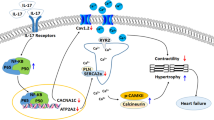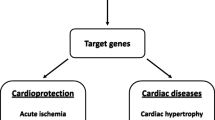Abstract
Objective
Disequilibrium of the cytokine network was reported to play an important role in the progression of chronic heart failure (CHF). Catechin exerts cardioprotection through treating many kinds of angiocardiopathy. However, the effects of catechin on CHF are currently unclear. Therefore, the main aim of this study was to investigate the efficacy of catechin on CHF rats as well as its relationship to immunoregulation.
Methods
CHF was induced in rats by ligation of the abdominal aorta. Myocardial function was evaluated by left ventricular systolic pressure and left ventricular end-diastolic pressure. The cytokine level was measured by enzyme-linked immunosorbent assay. Th17 and Treg levels in peripheral blood and spleen were analyzed by flow cytometry.
Results
The results showed that catechin treatment (50, 100 mg/kg/day) markedly improved myocardial function in rats treated with abdominal aortic coarctation. Severity of myocardial dysfunction in CHF rats significantly correlated with serum values of interleukin-17 (IL-17)/IL-10. Further results indicated catechin obviously inhibited immune activation, regulated unbalanced levels of IL-17/IL-10, and reversed abnormal polarization of TH17 as well as Treg in peripheral blood and spleen.
Conclusions
Taken together, oral administration of catechin effectively suppressed abdominal aorta ligation-induced CHF in rats, which was closely associated with its modulation on Th17 and Treg.






Similar content being viewed by others
References
Sciarretta S, Paneni F, Palano F, et al. Role of the renin-angiotensin-aldosterone system and inflammatory processes in the development and progression of diastolic dysfunction. Clin Sci (Lond). 2009;116:467–77.
Crowson CS, Liao KP, Davis JM 3rd, et al. Rheumatoid arthritis and cardiovascular disease. Am Heart J. 2013;166:622–628e1.
Buss SJ, Wolf D, Korosoglou G, et al. Myocardial left ventricular dysfunction in patients with systemic lupus erythematosus: new insights from tissue Doppler and strain imaging. J Rheumatol. 2010;37:79–86.
Yiu KH, Schouffoer AA, Marsan NA, et al. Left ventricular dysfunction assessed by speckle-tracking strain analysis in patients with systemic sclerosis: relationship to functional capacity and ventricular arrhythmias. Arthritis Rheum. 2011;63:3969–78.
Fujiu K, Nagai R. Contributions of cardiomyocyte-cardiac fibroblast-immune cell interactions in heart failure development. Basic Res Cardiol. 2013;108:357.
Milovanovic M, Pesic G, Nikolic V, et al. Vitamin D deficiency is associated with increased IL-17 and TNFα levels in patients with chronic heart failure. Arq Bras Cardiol. 2012;98:259–65.
Liu Y, Zhu H, Su Z, et al. IL-17 contributes to cardiac fibrosis following experimental autoimmune myocarditis by a PKCβ/Erk1/2/NF-κB-dependent signaling pathway. Int Immunol. 2012;24:605–12.
Tang TT, Ding YJ, Liao YH, et al. Defective circulating CD4 + CD25 + Foxp3 + CD127(low) regulatory T-cells in patients with chronic heart failure. Cell Physiol Biochem. 2010;25:451–8.
Dhingra S, Sharma AK, Arora RC, et al. IL-10 attenuates TNF-alpha-induced NF kappaB pathway activation and cardiomyocyte apoptosis. Cardiovasc Res. 2009;82:59–66.
Li N, Bian H, Zhang J, et al. Th17/Treg imbalance exists in patients with heart failure with normal ejection fraction and heart failure with reduced ejection fraction. Clin Chim Acta. 2010;411:1963–8.
Cialdai C, Giuliani S, Valenti C, et al. Differences between zofenopril and ramipril, two ACE inhibitors, on cough induced by citric acid in guinea pigs: role of bradykinin and PGE2. Naunyn Schmiedebergs Arch Pharmacol. 2010;382:455–61.
Cheng TO. All teas are not created equal: the Chinese green tea and cardiovascular health. Int J Cardiol. 2006;108:301–8.
Cai Y, Yu SS, Chen TT, et al. EGCG inhibits CTGF expression via blocking NF-κB activation in cardiac fibroblast. Phytomedicine. 2013;20:106–13.
Wu D, Wang J, Pae M, Meydani SN. Green tea EGCG, T cells, and T cell-mediated autoimmune diseases. Mol Aspects Med. 2012;33:107–18.
Liao X, He J, Ma H, et al. Angiotensin-converting enzyme inhibitor improves force and Ca2+––frequency relationships in myocytes from rats with heart failure. Acta Cardiol. 2007;62:157–62.
Ribeiro RF Jr, Potratz FF, Pavan BM, et al. Carvedilol prevents ovariectomy-induced myocardial contractile dysfunction in female rat. PLoS One. 2013;8:e53226.
Wang C, Yuan J, Wu HX, et al. Paeoniflorin inhibits inflammatory responses in mice with allergic contact dermatitis by regulating the balance between inflammatory and anti-inflammatory cytokines. Inflamm Res. 2013;62:1035–44.
Zhang LL, Wei W, Yan SX, et al. Therapeutic effects of glucosides of Cheanomeles speciosa on collagen-induced arthritis in mice. Acta Pharmacol Sin. 2004;25:1495–501.
Song SS, Huang B, Wang QT, et al. BF02, a recombinant TNFR2 fusion protein, alleviates adjuvant arthritis by regulating T lymphocytes in rats. Acta Pharmacol Sin. 2013;34:414–23.
Fang CB, Zhou DX, Zhan SX, et al. Amelioration of experimental autoimmune uveitis by leflunomide in Lewis rats. PLoS One. 2013;8:e62071.
Jiang XY, Gao GD, Zhou J, et al. Role of AT2 receptors on angiotensin II-induced tumor necrosis factor alpha and interleukin 1 beta secretion in adult rat cardiac fibroblasts. Nan Fang Yi Ke Da Xue Xue Bao. 2007;27:1307–9.
Gurantz D, Cowling RT, Varki N, et al. IL-1beta and TNF-alpha upregulate angiotensin II type 1 (AT1) receptors on cardiac fibroblasts and are associated with increased AT1 density in the post-MI heart. J Mol Cell Cardiol. 2005;38:505–15.
Afzali B, Lombardi G, Lechler RI, Lord GM. The role of T helper 17 (Th17) and regulatory T cells (Treg) in human organ transplantation and autoimmune disease. Clin Exp Immunol. 2007;148:32–46.
Longhi MS, Liberal R, Holder B, et al. Inhibition of interleukin-17 promotes differentiation of CD25− cells into stable T regulatory cells in patients with autoimmune hepatitis. Gastroenterology. 2012;142:1526–35.
Fujio K, Okamura T, Yamamoto K. The Family of IL-10-secreting CD4+ T cells. Adv Immunol. 2010;105:99–130.
Liu B, Tonkonogy SL, Sartor RB. Antigen-presenting cell production of IL-10 inhibits T-helper 1 and 17 cell responses and suppresses colitis in mice. Gastroenterology. 2011;141:653–62.
McGovern JL, Nguyen DX, Notley CA, et al. Th17 cells are restrained by Treg cells via the inhibition of interleukin-6 in patients with rheumatoid arthritis responding to anti-tumor necrosis factor antibody therapy. Arthritis Rheum. 2012;64:3129–38.
Feng W, Li W, Liu W, et al. IL-17 induces myocardial fibrosis and enhances RANKL/OPG and MMP/TIMP signaling in isoproterenol-induced heart failure. Exp Mol Pathol. 2009;87:212–8.
Liu W, Wang X, Feng W, et al. Lentivirus mediated IL-17R blockade improves diastolic cardiac function in spontaneously hypertensive rats. Exp Mol Pathol. 2011;91:362–7.
Stumpf C, Petzi S, Seybold K, et al. Atorvastatin enhances Interleukin-10 levels and improves cardiac function in rats after acute myocardial infarction. Clin Sci (Lond). 2009;116:45–52.
Kaur K, Sharma AK, Singal PK. Significance of changes in TNF-alpha and IL-10 levels in the progression of heart failure subsequent to myocardial infarction. Am J Physiol Heart Circ Physiol. 2006;291:H106–13.
Verma SK, Krishnamurthy P, Barefield D, et al. Interleukin-10 treatment attenuates pressure overload-induced hypertrophic remodeling and improves heart function via signal transducers and activators of transcription 3-dependent inhibition of nuclear factor-κB. Circulation. 2012;126:418–29.
Stumpf C, Seybold K, Petzi S, et al. Interleukin-10 improves left ventricular function in rats with heart failure subsequent to myocardial infarction. Eur J Heart Fail. 2008;10:733–9.
Yu Y, Zhang ZH, Wei SG, et al. Central gene transfer of interleukin-10 reduces hypothalamic inflammation and evidence of heart failure in rats after myocardial infarction. Circ Res. 2007;101:304–12.
Kvakan H, Kleinewietfeld M, Qadri F, et al. Regulatory T cells ameliorate angiotensin II-induced cardiac damage. Circulation. 2009;119:2904–12.
Rosen T. Green tea catechins: biologic properties, proposed mechanisms of action, and clinical implications. J Drugs Dermatol. 2012;11:e55–60.
Luckheeram RV, Zhou R, Verma AD, Xia B. CD4+ T cells: differentiation and functions. Clin Dev Immunol. 2012;2012:925135.
Aoyagi T, Matsui T. Phosphoinositide-3 kinase signaling in cardiac hypertrophy and heart failure. Curr Pharm Des. 2011;17:1818–24.
Chen DD, Dong YG, Liu D, He JG. Epigallocatechin-3-gallate attenuates cardiac hypertrophy in hypertensive rats in part by modulation of mitogen-activated protein kinase signals. Clin Exp Pharmacol Physiol. 2009;36:925–32.
Divakaran VG, Evans S, Topkara VK, et al. Tumor necrosis factor receptor-associated factor 2 signaling provokes adverse cardiac remodeling in the adult mammalian heart. Circ Heart Fail. 2013;6:535–43.
Li HL, Huang Y, Zhang CN, et al. Epigallocathechin-3 gallate inhibits cardiac hypertrophy through blocking reactive oxidative species-dependent and -independent signal pathways. Free Radic Biol Med. 2006;40:1756–75.
Jiang J, Mo ZC, Yin K, et al. Epigallocatechin-3-gallate prevents TNF-α-induced NF-κB activation thereby upregulating ABCA1 via the Nrf2/Keap1 pathway in macrophage foam cells. Int J Mol Med. 2012;29:946–56.
Acknowledgments
This work was supported by the Anhui Province Nature Science Foundation in the University (kj2013z125).
Conflict of interest
The authors have no conflict of interest to declare.
Author information
Authors and Affiliations
Corresponding author
Additional information
Responsible Editor: Liwu Li.
Rights and permissions
About this article
Cite this article
Zhang, Q., Hu, Lq., Yin, Cs. et al. Catechin ameliorates cardiac dysfunction in rats with chronic heart failure by regulating the balance between Th17 and Treg cells. Inflamm. Res. 63, 619–628 (2014). https://doi.org/10.1007/s00011-014-0734-4
Received:
Accepted:
Published:
Issue Date:
DOI: https://doi.org/10.1007/s00011-014-0734-4




